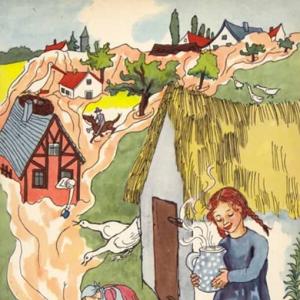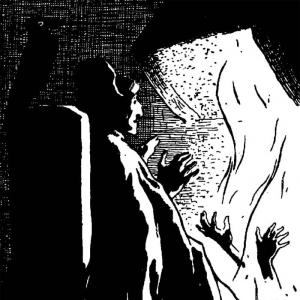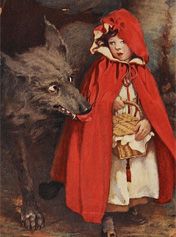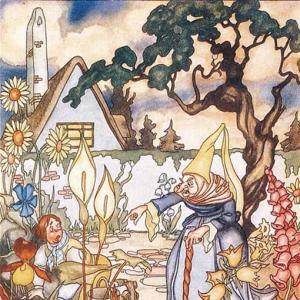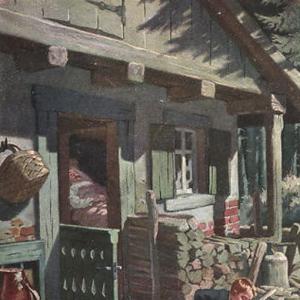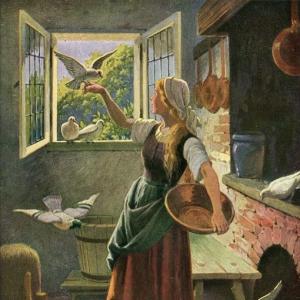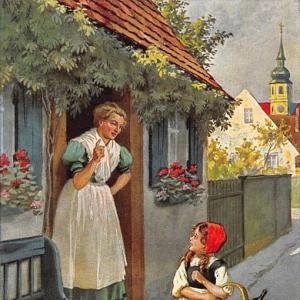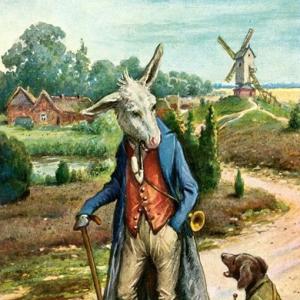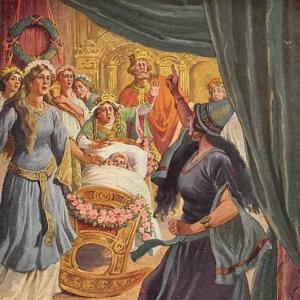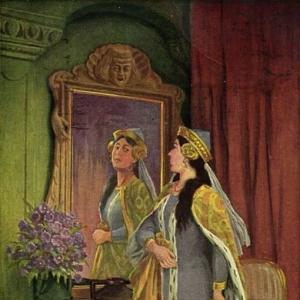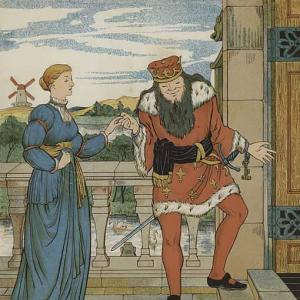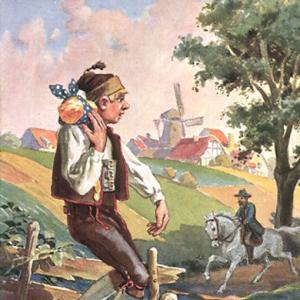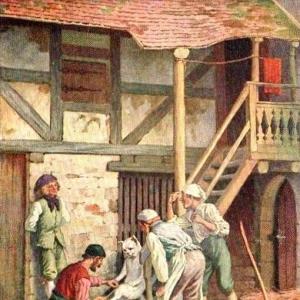Reading time for children: 6 min
Have you ever seen „a maiden“? I am referring to what road pavers call a „maiden,“ a thing used for ramming down the paving stones. „She“ is made entirely of wood, broad at the bottom, with iron hoops around it, and a stick run through it at the upper, narrower end, which gives the maiden arms.
Two maidens like this were once standing in the yard shed, among shovels, measuring tapes, and wheelbarrows. Now, there was a rumor going around that they were no longer to be called „maidens,“ but „stamps“ or „hand rammers“; and this is the newest and only correct term in road pavers‘ language for what we all in olden times called „a maiden.“
There are among us human beings certain individuals we call „emancipated women,“ such as institution superintendents, midwives, ballet dancers, milliners, and nurses; and with this group of „emancipated,“ the two „maidens“ in the yard shed associated themselves. They were known as „maidens“ among the road pavers and would under no circumstances give up their good old name and let themselves be called „stamps“ or „hand rammers.“
Maiden is a human name,“ they said, „but a stamp or a hand rammer is a thing, and we certainly do not want to be called things. That’s insulting us!“ – „My betrothed is liable to break off our engagement,“ said the younger of the two, who was engaged to a ramming block, a large machine used to drive stakes into the ground. In fact, he did on a larger scale the same sort of work that she did on a smaller. „He’ll take me as a maiden, but I’m sure he won’t have me as a stamp or hand rammer, and so I’ll not permit them to change my name.“
„As for me, I’d just as soon have both my arms broken off!“ said the elder. But the wheelbarrow had a different idea, and the wheelbarrow was really somebody! He considered himself a quarter of a carriage because he went about on one wheel. „I must, however, tell you that it’s common enough to be called maidens. That isn’t nearly so distinctive a name as stamp, because that belongs under the category of seals. Just think of the royal signet, and the ’seal of the state.‘ If I were you I would give up the name maiden.“
„Never!“ said the elder. „I’m much too old for that!“ – „You don’t seem to understand what is called the European necessity,“ said the honest old measuring tape. „People have to adapt themselves to circumstances, limit themselves, give in to the needs of the times. And if there is a law that the ‚maidens‘ are to be called stamps or hand rammers, then by that new name she must be called. There is a measuring tape for everything.“
„Well, if there must be a change,“ said the younger, „I’d rather be called miss, for miss reminds one a little of maiden.“ – „But I’d rather be chopped up for firewood than change at all,“ said the old „maiden.“ Now it was time for work. The „maidens“ rode. They were put in the wheelbarrow, which was respectful treatment, but they were now called „stamps.“
„Maid!“ they cried as they stamped on the paving stones. „Maid!“ They almost said the whole word „maiden,“ but they didn’t finish. They had decided not to say any more about it. But among themselves they always spoke of each other as „maidens,“ and praised the good old days when things were called by their proper names and those who were „maidens“ were called „maidens.“ And „maidens“ they both remained, for the ramming block, the big machine I told you about, did break off his engagement with the younger. He would have nothing to do with a „stamp“ or „hand rammer“!
 Learn languages. Double-tap on a word.Learn languages in context with Childstories.org and Deepl.com.
Learn languages. Double-tap on a word.Learn languages in context with Childstories.org and Deepl.com.Backgrounds
Interpretations
Summary
Linguistics
„Two Maidens“ is a lesser-known fairy tale written by the renowned Danish author Hans Christian Andersen. Born on April 2, 1805, and passing away on August 4, 1875, Andersen was a prolific writer known for his children’s stories, which often contained moral lessons and fantastical elements. Many of his tales, such as „The Little Mermaid,“ „The Ugly Duckling,“ and „The Emperor’s New Clothes,“ have become classics and are beloved by children and adults alike.
Andersen’s fairy tales were often inspired by folktales and legends from various cultures, as well as his own life experiences and vivid imagination. He had a talent for infusing his stories with relatable themes and emotions, making them accessible to a wide audience.
In „Two Maidens,“ Andersen presents a story centered around the personification of inanimate objects, a common literary device he employed in his works. This technique allows him to explore human emotions, behaviors, and dilemmas through the interactions and experiences of non-human characters.
As a writer, Andersen was skilled at using seemingly simple stories to delve into deeper, more profound themes. „Two Maidens“ may not be as widely recognized as some of his other works, but it still carries the same thought-provoking themes and timeless lessons found in his more famous fairy tales.
„Two Maidens“ by Hans Christian Andersen can be interpreted in several ways, with themes such as resistance to change, the importance of identity, and the consequences of stubbornness.
Resistance to change: The story reflects people’s natural resistance to change, especially when it comes to traditions and established customs. The two maidens struggle to accept the new names, as they feel a strong attachment to their old identity. This resistance to change is common in society, as people often find comfort in familiarity.
Importance of identity: The maidens‘ insistence on keeping their original name highlights the significance of identity and self-perception. The human-like name „maiden“ gives them a sense of dignity and individuality, which they fear will be lost if they adopt the new, more object-like names. This theme resonates with the broader human experience, as people often hold on to their identities to maintain a sense of self and belonging.
Consequences of stubbornness: The story also explores the consequences of stubbornness and an unwillingness to adapt. The younger maiden’s insistence on keeping her old name ultimately leads to the end of her engagement with the ramming block. This outcome suggests that an unwillingness to adapt to new circumstances and accept change can have negative consequences in one’s life.
Adaptation and societal pressure: The perspectives of the wheelbarrow and the measuring tape emphasize the importance of adapting to new circumstances and societal expectations. They argue that change is necessary and that it’s crucial to follow new rules, even if it means losing a part of one’s identity. This theme reflects the real-world struggle many people face when trying to balance societal pressures with their individual identities.
Overall, „Two Maidens“ can be interpreted as a commentary on the complexities of human identity, resistance to change, and the consequences of stubbornness in the face of evolving societal norms.
„Two Maidens“ by Hans Christian Andersen is a fairy tale about two wooden tools used by road pavers, called „maidens.“ These tools, used for ramming down paving stones, were rumored to be renamed as „stamps“ or „hand rammers.“ The two maidens, proud of their human-like name, refused to give it up, feeling that the new names were insulting.
The younger maiden was engaged to a ramming block, a larger machine that did similar work. She worried that her fiancé would break off their engagement if she allowed herself to be called by a different name. The elder maiden was also adamant about keeping her name and would rather have her arms broken off than change it.
Other tools in the yard shed, like the wheelbarrow and the measuring tape, offered their perspectives. The wheelbarrow, considering itself a quarter of a carriage, argued that „stamp“ was a more distinguished name. The measuring tape emphasized the importance of adapting to circumstances and the necessity of following the new naming law.
The younger maiden suggested being called „miss,“ as it was somewhat reminiscent of „maiden.“ However, the elder maiden refused any change at all. When it was time for work, they were called „stamps“ but continued to call each other „maidens“ privately. The tale ends with the ramming block breaking off his engagement with the younger maiden, unwilling to be associated with a „stamp“ or „hand rammer.“
Hans Christian Andersen’s tale „Two Maidens“ serves as an insightful allegory exploring themes of identity, change, and resistance to societal evolution through a peculiar linguistic transformation. At its core, the story addresses how language influences identity and societal roles, and how individuals respond to changes in terminology that affect their sense of self.
Metaphorical Language: The narrative anthropomorphizes inanimate objects like rammers, wheelbarrows, and measuring tapes, attributing them human-like characteristics and emotions. This humanization is pivotal in exploring the concept of identity, as it juxtaposes the linguistic changes with personal self-conceptions and societal perceptions.
Terminology and Identity: The shift from „maidens“ to „stamps“ or „hand rammers“ symbolizes a broader societal and linguistic transformation. The objects‘ resistance to the name change reflects anxiety about losing identity and status. Calling rammers „maidens“ ties them to a noble, human-linked identity, whereas „stamps“ reduces them to mere functional objects.
Symbolism: „Maiden“ signifies more than just a name; it represents tradition, dignity, and a personal connection to historical identity. Conversely, „stamp“ or „hand rammer“ symbolizes modernization and the utilitarian view of entities as mere tools devoid of heritage.
Internal vs. External Language: Internally, among themselves, the rammers continue to use the term „maidens,“ preserving their self-identity against societal pressures. This reflects the tension between private identity and public nomenclature, highlighting a common human struggle with adapting to externally imposed changes.
Societal Themes
Resistance to Change: The elder “maiden’s” adamant stance against the new terminology represents an inherent resistance to change that challenges one’s identity. This resistance is a common human theme, symbolizing broader social struggles with modernization and the fear of losing longstanding cultural identities.
Emancipation and Gender Roles: The tale cleverly mirrors human society by using terms traditionally associated with women, such as „maidens,“ and aligning their struggle with that of „emancipated women. “ It suggests an exploration of gender roles and the fight for maintaining identity amidst evolving societal norms.
Conformity vs. Individuality: There is pressure from other characters, like the wheelbarrow and the measuring tape, to conform to new societal rules for the sake of modernity and necessity. This reflects a broader commentary on the balance between individual identity and societal conformity.
In conclusion, „Two Maidens“ provides a rich tapestry for linguistic analysis, cleverly using allegory to discuss deeper issues of identity, language, and societal change. Andersen’s tale can be seen as a subtle critique of modernity’s impact on personal and collective identities, resonating with timeless human concerns about change and self-definition.
Information for scientific analysis
Fairy tale statistics | Value |
|---|---|
| Translations | DE, EN, DA, ES |
| Readability Index by Björnsson | 29.6 |
| Flesch-Reading-Ease Index | 77.4 |
| Flesch–Kincaid Grade-Level | 6.4 |
| Gunning Fog Index | 8.8 |
| Coleman–Liau Index | 9.1 |
| SMOG Index | 9 |
| Automated Readability Index | 6.4 |
| Character Count | 3.527 |
| Letter Count | 2.681 |
| Sentence Count | 40 |
| Word Count | 633 |
| Average Words per Sentence | 15,83 |
| Words with more than 6 letters | 87 |
| Percentage of long words | 13.7% |
| Number of Syllables | 848 |
| Average Syllables per Word | 1,34 |
| Words with three Syllables | 40 |
| Percentage Words with three Syllables | 6.3% |

